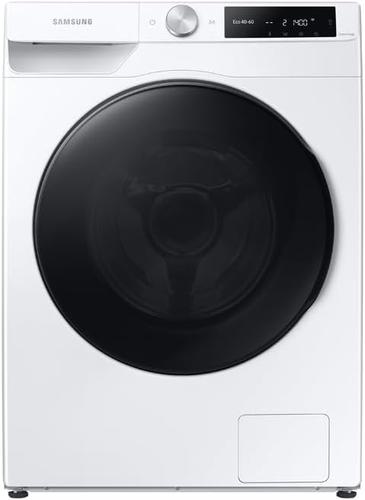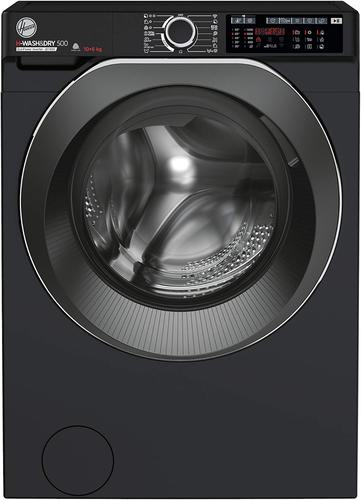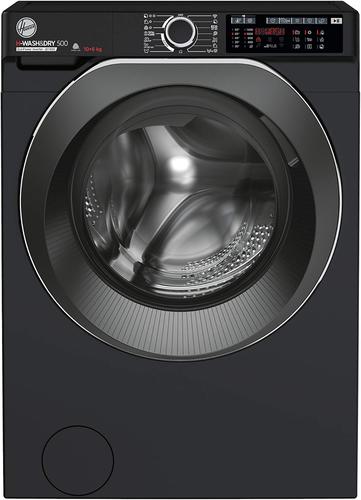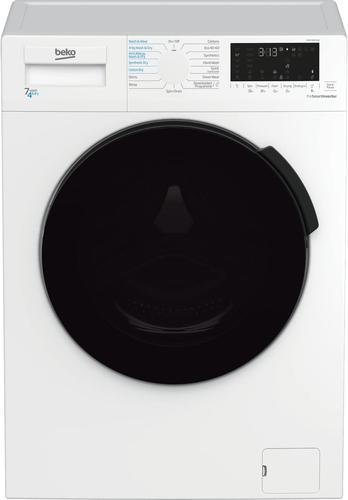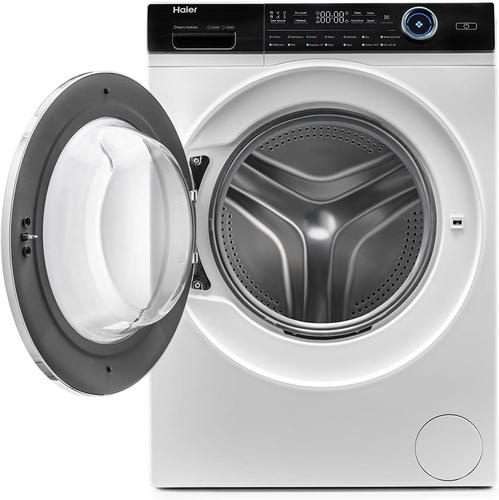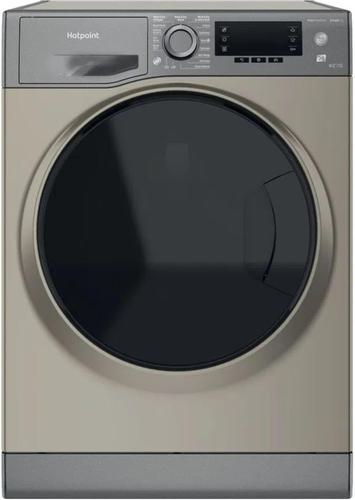What are the best washer-dryers brands?
The best washer-dryer brands (with the highest overall score) are as follows.
- Samsung (Average overall score: 8 )
- Hoover (Average overall score: 7.8 )
- Beko (Average overall score: 7.8 )
The following chart ranks brands based on their overall scores.
[horizontal-chart-33878136557124569]
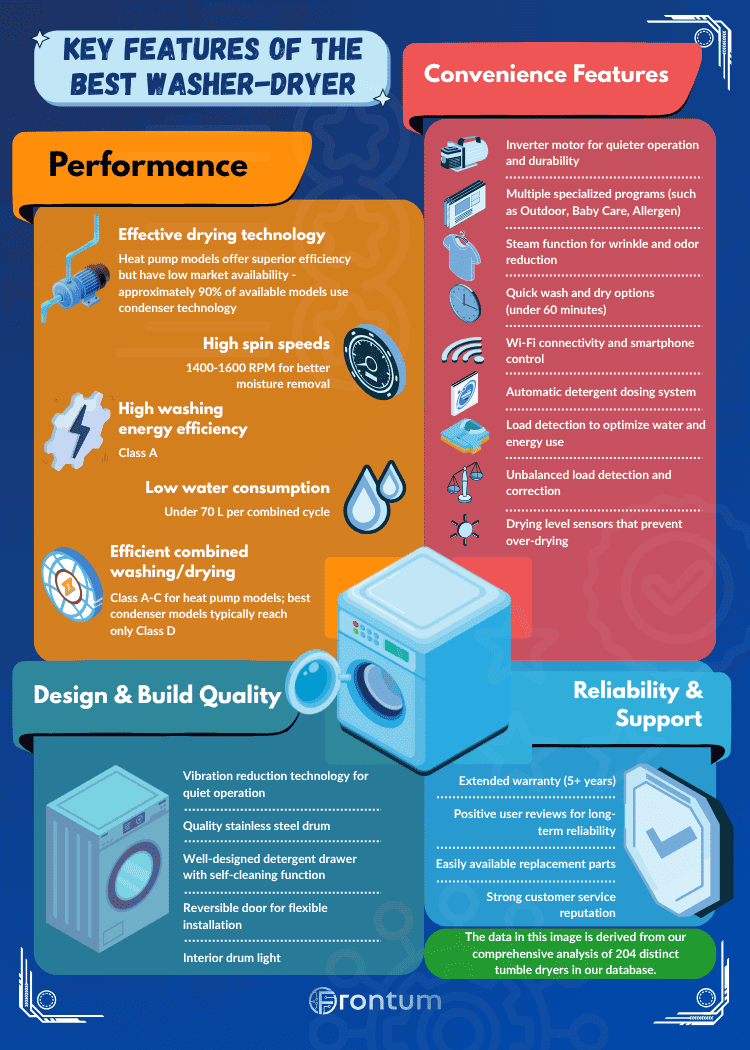
Which dryer brands have the highest user ratings?
The washer-dryer brands with the highest user ratings are as follows.
- Samsung (Average user rating: 8.4 )
- Hisense (Average user rating: 8.4 )
- LG (Average user rating: 8.3 )
The following chart ranks brands according to their user ratings.
[horizontal-chart-33108135743723520]
Which dryer brands offer the best value for money?
The following washer-dryer brands offer the best ratio quality-price.
- Beko (Average ratio quality-price score: 8 )
- Candy (Average ratio quality-price score: 7.7 )
- Hoover (Average ratio quality-price score: 7.5 )
The chart below compares brands based on their quality-price ratio.
[horizontal-chart-39161741706525879]
Heat pump vs Condenser: Which type of washer-dryer is the best?
The best type of washer-dryer depends on what you value more: energy savings, upfront cost, installation, or drying time.
Heat pump washer-dryers use lower temperatures, so they use much less electricity and stay gentler on clothes. You pay more upfront, but you save on energy in the long run. Heat pump models usually cost more than condenser models, but they cut electricity use over time so the higher price pays itself off in a few years. They use advanced heat pump technology, which recycles hot air instead of releasing it. This system dries clothes slowly but with high energy efficiency. Heat pump technology has the best energy performance, but it is rare in washer-dryers.
Condenser washer-dryers sit in the middle range for both cost and complexity. They use a simpler system that heats air to dry clothes, then condenses the moisture into water. This uses more energy and higher heat than heat pump models, so drying costs more and clothes face more wear. You can install condenser units anywhere with power and drainage, so you get more flexibility.
The following chart illustrates the distribution between heat pump and condenser washer-dryers.
[pie-chart-18995718911517834]
Heat pump washer-dryers have the following advantages compared to condenser washer-dryers:
- Inverter motor in all models: All heat pump washer-dryers we analysed include an inverter motor, while this is not always the case in condenser washer-dryers.
- Lower energy consumption: Heat pump washer-dryers consume on average 275 kWh per 100 combined cycles compared to 322 kWh for condenser washer-dryers.
- Higher washing energy efficiency class: Around 63% of heat pump washer-dryers belong to class A, while only 50% of condenser washer-dryers fall into this class.
- Lower water usage per cycle: Heat pump washer-dryers consume on average 59 litres of water per combined cycle, which is 21 litres less than condenser washer-dryers (80 litres).
- Higher spin speed range: Most heat pump washer-dryers reach at least 1400 RPM and go down to a minimum of 400 RPM, which is useful for delicate clothes.
- More specialized programs: Many heat pump washer-dryers include programs like Gentle, Wool, Outdoor/Sport, Duvet and Baby Care.
- More functional options: Heat pump washer-dryers include functions such as Anti-stain function, Prewash function, Steam function, Fast cycle option, Extra Rinse function, Anti-crease function, Night/Silent option and Power Save mode.
- More built-in features: Heat pump washer-dryers have on average 18 features, which is 4 more than the average condenser washer-dryer.
- More automatic functions: Almost all heat pump washer-dryers include a laundry detection system, automatic drying, unbalanced load detection, delay start option, selectable drying level, selectable drying times and Pause & Add feature.
Condenser washer-dryers have the following advantages compared to heat pump washer-dryers:
- Simpler mechanism: Condenser washer-dryers use a less complex system, so they face fewer potential repair issues compared to heat pump washer-dryers
- No external vent needed: Condenser washer-dryers collect moisture in a tank or drain it, so users can place them in any room without ventilation
- Higher market availability: Condenser washer-dryers have more models on the market compared to heat pump washer-dryers
- Shorter ECO cycle: Condenser washer-dryers complete the ECO cycle in 220 minutes on average, while heat pump washer-dryers take 235 minutes
- More washing programs: Condenser washer-dryers include 13 washing programs on average, compared to 12 in heat pump washer-dryers
- More special programs: Condenser washer-dryers include Colors, Hygiene and Allergen cycles more often than heat pump washer-dryers
- More advanced features: Condenser washer-dryers include features like Pre-mix technology, Automatic drawer cleaning, Water Jets system, Bluetooth and Smart Diagnosis more often than heat pump washer-dryers
- Special drum and antivibration design: More advanced condenser washer-dryers use special drum shapes and antivibration design more often than heat pump washer-dryers
What is the ideal washer-dryer capacity?
The ideal washer-dryer capacity depends on how many people use it, how often you do laundry, and what kind of items you usually wash and dry.
Washer-dryers with less than 7 kg washing capacity and less than 5 kg drying capacity fit singles or couples without children. These handle small, frequent loads like everyday clothes, light fabrics, and a few towels. On average, these models have a drum volume of 52 litres, use 69 kWh per 100 washing cycles, and cost around £470. About 8% of washer-dryers on the market fall in this range. These machines often consume more energy, even with smaller loads.
Models with 8–9 kg washing capacity and 5–7 kg drying capacity suit small families (3–4 people). These work well for regular laundry like clothes, bed linens, and towels. They have a drum volume of 58 litres, consume about 55 kWh per 100 washing cycles, and cost around £530. Around 66% of washer-dryers on the market have this capacity.
Washer-dryers with more than 10 kg washing capacity and more than 7 kg drying capacity fit larger families (5 or more people). These support big loads like bed linens, towels, and medium-sized items like light blankets and comforters. These machines have a drum volume of 70 litres and consume 51 kWh per 100 washing cycles, although energy use can increase in models with 12+ kg drying capacity. They cost around £670 and make up 26% of the market.
There is a direct link between capacity and price—larger machines usually cost more.
When you choose drying capacity, consider the following factors:
- Laundry frequency: If you do laundry less often, a larger capacity helps you finish in fewer cycles.
- Types of items: If you dry bulky items like blankets, duvets, or curtains, a higher capacity works better.
- Space availability: Larger machines need more room, so check if your laundry space fits the size.
The chart below illustrates how washing capacities are distributed across washer-dryer models.
[pie-chart-18146118299417536]
What are slim washer-dryers and when to buy one?
Slim washer-dryers are washer-dryers with a depth under 50 cm. You should buy one if you have limited space and need a compact machine. Only about 8% of all washer-dryers on the market are slim. A slim washer-dryer has about 20% less volume than average (0.24 m³ vs 0.30 m³), so it takes up less space.
Slim models can suit small apartments or tight laundry areas. Keep in mind that smaller volume usually means lower capacity, so slim machines may not handle large loads well.
The following chart shows the distribution of depth measurements among washer-dryer models.
[vertical-chart-14381715412216382]
Which energy class do the best washer-dryers have?
The best washer-dryers have washing energy class A or B.
The distribution of washing energy classes across all washer-dryers on the market is as follows:
- A class: 48%
- B class: 19%
- C class: 18%
- D class: 12%
- E class: 3%
- F class: less than 1%
Some brands use terms like A-10% or A-20% to show their models use 10% or 20% less energy than standard A class washer-dryers, but these labels do not officially exist and do not appear on energy labels.
Every washer-dryer also has a combined energy class based on its full washing and drying cycle. The distribution of combined energy classes across the market is as follows:
- A class: less than 1%
- B class: less than 1%
- C class: less than 1%
- D class: about 46%
- E class: about 47%
- F class: about 4%
Washer-dryers with combined energy class A-C are nearly non-existent. The best washer-dryers usually reach D combined class, which may seem low, but the test standards are strict and very few models can score higher.
Energy classes follow standardized EU regulations:
- Washing energy class (wash-only mode): based on energy consumption during Eco 40-60 program at full, half, and quarter load, calculated as a weighted average per 100 cycles
- Combined energy class (wash & dry mode): based on energy use for full washing and drying cycle at full and half load, also calculated as a weighted average per 100 cycles

The distribution of washing energy efficiency classes across washer-dryers is presented in the chart below.
[pie-chart-28315828093821883]
How much energy do the most efficient washer-dryers consume?
The most efficient washer-dryers consume from 42 to 56 kWh per 100 washing cycles, with an average of 49 kWh, which stays below the market average of 55 kWh. For 100 combined wash and dry cycles, Class A washer-dryers use between 190 and 380 kWh, with an average of 308 kWh (slightly lower than the market average of 318 kWh). Energy use increases with capacity, so high-capacity models (like those with 14 kg) can reach 56 kWh per 100 washing cycles and still fall under Class A.
Washer-dryers in lower energy classes consume more, as follows:
- Class B: 57 kWh per 100 washing cycles (about 15% more than Class A)
- Class C: 63 kWh per 100 washing cycles (about 30% more than Class A)
- Class D: 70 kWh per 100 washing cycles (about 40% more than Class A)
Energy consumption varies with capacity and combined drying use, so higher numbers appear in full cycles compared to washing-only cycles.
How quiet are the best washer-dryers?
The best washer-dryers stay quiet. They produce less than 72 dB during the spin cycle, less than 53 dB during washing, and less than 61 dB during drying. These models make up around 40% of the market.
If noise matters to you, check the decibel rating in the product specifications or look for models labeled "quiet operation". Go for anything under 72 dB. If you want an ultra-quiet machine, pick one that stays under 70 dB during spin (these make up around 10% of all models).
What makes some washer-dryers more quiet than others?
Some washer-dryers stay more quiet than others because they use better motor technology, advanced insulation, improved drum design, and noise-reducing systems.
The following features reduce noise levels in washer-dryers:
- Inverter motors: These reduce vibrations and noise compared to conventional motors. 89%% of all washer-dryers include an inverter motor and 98% of quiet washer-dryers (under 72 dB) use it
- Special drum design: A well-designed drum reduces noise by lowering friction and spreading laundry more evenly during the cycle. 48%% of all washer-dryers have this feature and 85% of quiet washer-dryers include it
- Vibration reduction: Shock absorbers, stabilizing systems, and anti-vibration pads or feet help reduce operational noise
- Advanced insulation: Extra layers inside the machine reduce sound during washing and drying cycles
- Quiet functions/cycles: Present in 100%% of all washer-dryers, these cycles run at lower noise levels compared to standard ones
The distribution of spin cycle noise levels across washer-dryers is illustrated in the following chart.
[vertical-chart-20920021770418992]
How many drying programs do the best washer-dryers have?
The best washer-dryers usually have 4 or more drying programs (only 10% of washer-dryers have more than 4 drying programs). Most washer-dryers have 3-4 drying programs.
The best models also have 14 or more washing programs. 36% of washer-dryers have 14 or more programs and 16% have 16 or more programs. Washer-dryers in general have between 5 and 23 washing programs, with an average of 13.
All washer-dryers usually include the basic drying programs such as Cottons, Synthetics and Mix.
Washer-dryers differ in specialized programs. The most common ones are as follows:
- Wool (100%)
- Gentle cycle (100%)
- Refresh cycle (75%)
- Allergy cycle (100%)
- Hygiene cycle (100%)
- Outdoor/Sport cycle (100%)
- Colors cycle (100%)
- Shirt cycle (17%)
- Duvet cycle (100%)
- Jeans cycle (13%)
- Baby-care cycle (10%)
Some brands like Hoover or Candy connect the tumble dryer to your phone. You can then download and use about 40–60 additional programs through their app.
More washing and drying programs give you greater versatility and better control of how you care for different fabrics and load sizes. This improves washing and drying results and protects your clothes.
Which drying functions do the best washer-dryers have?
The best washer-dryers include the following drying functions that improve performance, reduce wrinkles, and support energy efficiency.
- Prewash function/cycle (82% of models): This function activates a preliminary wash cycle before the main wash. It removes heavy dirt from heavily soiled laundry. You should use it when washing clothes with mud, grease, or protein-based stains.
- Anti-stain function (69%): This function adjusts water temperature, drum movements, and cycle duration to target common stains (i.e. wine, coffee, or grass). The machine applies specific washing algorithms to break down stubborn dirt particles during the wash phase.
- Steam function (86%): Steam releases at specific points in the cycle to reduce wrinkles, soften fabrics, and help sanitize laundry. It reduces ironing time and can help eliminate allergens or bacteria in textiles. Many washer-dryers activate steam during the final rinse or post-wash phase.
- Extra-Rinse function (67%): This function adds one or more rinses at the end of the wash cycle. It removes detergent residues and is useful for sensitive skin or baby clothes.
- Anti-crease function (55%): This function activates post-drying movement of the drum that prevents fabric clumping. It reduces wrinkles and keeps clothes more manageable after drying. You get smoother results and avoid extended ironing.
- Fast cycle option (37%): This function shortens the washing and drying time. You should use it for small loads or lightly soiled garments. Machines use more energy or water to keep washing quality high while reducing total cycle time.
- Water+ option (7%): This function increases water levels during the washing cycle. It improves rinsing efficiency and benefits users with hard water or skin sensitivity. Machines automatically adjust the volume based on load weight and fabric type.
- Night/Silent option (100%): This function reduces drum movement and lowers motor noise during the cycle. You can run it at night or in shared spaces. Machines reduce spin speed and use insulated panels to absorb vibration.
- Power Save mode (100%): This function reduces energy consumption. Machines lower washing temperature and optimize motor speed to reduce electricity use without affecting performance.
- Soak function (12%): This function holds clothes in water for a set period before washing. It loosens dirt and stains. You can use it for clothes with dried-in stains or long-neglected laundry.
What are the common features of washer-dryers?
The most common features of washer-dryers are as follows. These features appear in nearly all models, and they directly affect how the machine performs during washing and drying cycles.
- Delay start option (in 100% of washer-dryers models): You can set the machine to begin a cycle at a specific time. This helps you manage energy consumption or schedule laundry around your day. Most machines let you delay start for several hours. You usually set this with a dedicated button or dial on the control panel.
- Unbalanced load detection (95%): The machine monitors drum rotation to detect when clothes are unevenly distributed. If the load sits off-balance, it adjusts the spin speed or redistributes the load before continuing. This reduces vibration and protects internal parts during high-speed spins.
- Laundry detection system (91%): The washer-dryer uses sensors to detect the weight and sometimes the type of laundry. It adjusts water, energy use, and program length automatically. This improves efficiency, especially in models with integrated weighing sensors and intelligent washing logic.
- Automatic drying (91%): This feature uses sensors to track moisture levels during the drying phase. The machine stops drying once it detects the selected dryness level. It prevents overdrying and helps optimize energy use. Some models combine this with a temperature sensor for better accuracy.
- Inverter motor (89%): Most models use brushless inverter motors. These motors adjust speed with electronic control (not mechanical brushes), so they reduce noise and last longer. They use direct drive or belt drive systems depending on brand. You get more stable performance at high spin speeds and lower energy use over time.
- Selectable drying level (85%): You can choose how dry you want the clothes to be at the end. Most models include settings like Iron Dry, Cupboard Dry, and Extra Dry. The machine adjusts time and temperature based on this. Some models link these settings to fabric type for better results.
Almost all washer-dryers also include child lock, pause, and selectable drying times. You can lock the control panel to prevent changes during a cycle (child lock), stop the machine mid-cycle to add items (pause), or pick exact drying times instead of automatic drying (selectable drying times).
What features do the best washer-dryers include?
The best washer-dryers include the following advanced features.
- Foam control system (59%): This system detects excess foam during washing, then adjusts rinsing parameters to improve detergent removal and reduce re-wash cycles.
- Smart diagnosis (46%): It detects errors or malfunctions and transmits data to technical support, so you reduce unnecessary service calls.
- Wash assist (42%): This technology helps you select the correct wash cycle based on fabric type and load weight.
- Favorite function (46%): You can store custom washing and drying settings, so you start frequent programs quickly.
- Automatic load balancing during spin (39%): Sensors distribute weight evenly in the drum to reduce vibrations, noise, and mechanical stress during spinning.
- Pre-mix technology (38%): This mixes water and detergent before injection into the drum, so it improves wash performance and reduces detergent waste.
- Acqua Stop (39%): A safety system that detects leaks in the inlet hose or internal circuits and blocks water flow to prevent flooding.
- Consumption statistics (37%): It tracks electricity and water usage for each program, so you monitor efficiency and optimize settings.
- Wi-Fi (31%): Enables remote program selection and control via smartphone apps, and receives software updates and maintenance alerts.
- Water Jets system (27%): High-pressure jets spray water directly on clothes during the wash phase to enhance cleaning and speed up rinsing.
- AI (17%): Artificial Intelligence analyses load weight, fabric type, and soil level to automatically adjust wash parameters.
- Eco indicator (14%): It visually displays expected energy and water consumption before starting a cycle, so you compare efficiency between programs.
- Automatic drawer cleaning (13%): It flushes detergent and softener compartments with water at high pressure, so residues do not accumulate.
- Scan function (11%): It scans fabric labels using your smartphone and recommends compatible washing and drying programs.
- Automatic dosing system (9%): This system calculates and injects the exact amount of detergent and softener based on load type and weight.
- NFC (9%): Near Field Communication pairs the appliance with your smartphone by touch to upload custom programs or access diagnostics.
The best washer-dryers also usually include a special drum design (48%) which uses a smooth internal surface and specific drum pattern to reduce friction and protect fabrics during the cycle. Most high-end models also feature anti-vibration design (7%) that adds mechanical stability and reduces noise during spinning. Some units include an interior light (8%) so you can clearly see the drum contents during loading or unloading.
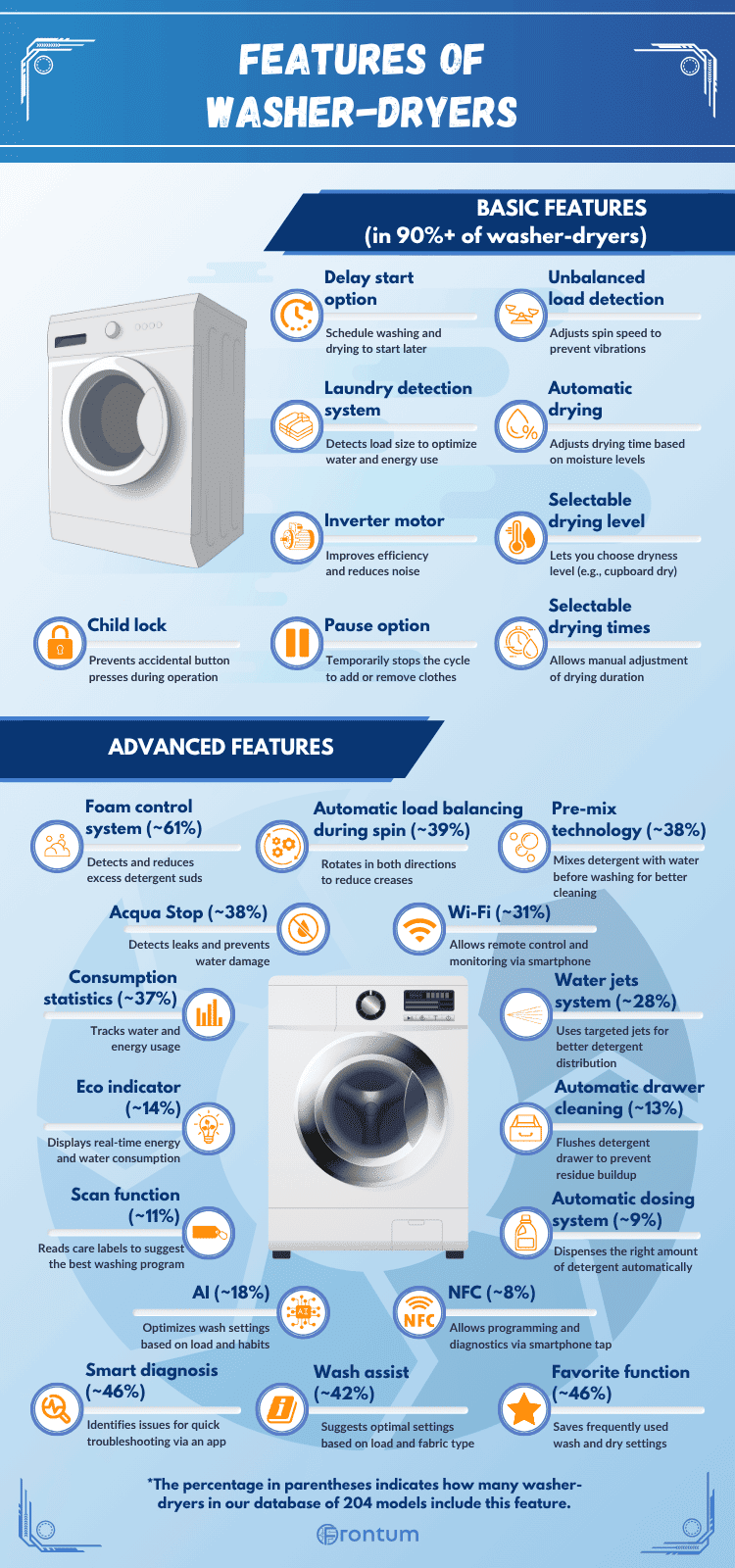
The chart below shows the distribution of the number of features across washer-dryer models.
[vertical-chart-19175920358118626]
The washer-dryer brands with the most features on average are as follows.
- Hoover (Average number of features: 25 )
- Samsung (Average number of features: 23 )
- Candy (Average number of features: 21 )
Which motor type do the best washer-dryers have?
The best washer-dryers have an inverter motor. About 89% of all washer-dryers use this motor type.
An inverter motor is a brushless direct current motor (BLDC) that uses variable frequency drive technology to control speed and torque. It works through electromagnetic induction, which creates a rotating magnetic field. This motor uses less energy, runs more quietly, and lasts longer than a traditional universal motor. Washer-dryers with an inverter motor use about 3 kWh less energy per 100 washing cycles (52 kWh vs 55 kWh) and usually come with a 10 to 20-year warranty.
Different brands use different names for inverter motors. Beko calls it ProSmart, Bosch uses Eco Silence Drive, Haier names it Direct Motion, Hoover uses Eco Power inverter, Samsung calls it Digital inverter, and Miele uses ProfiEco. The core inverter technology remains the same across these brands, but they apply it differently. Some focus more on reducing noise or increasing durability, while others focus on better energy efficiency.
How much do the best washer-dryers cost?
The best washer-dryers (average overall score 7.5+ points) cost on average £605£, while the average washer-dryer on the market costs £520£. You pay more for better performance, higher energy efficiency, quieter operation, and features like SteamCare, Iron Assist, AutoDry, or Hygiene program.
The price distribution across washer-dryers is presented in the following chart.
[vertical-chart-14365115417416314]
To which price categories washer-dryers could be divided?
Washer-dryers can be divided into three price categories: bottom range (£430 or less), mid range (£430–£680), and top range (£680+).
In the bottom range (£430 or less), you can find washer-dryers with various capacities. The most common washing capacity is 8 kg, followed by 9 kg and 7 kg, and drying capacities of 6 kg and 5 kg. Many models still reach a 10 kg washing capacity or 7 kg drying capacity, although they cost less. You can also find compact models with 7 kg or smaller capacity. These machines consume around 55 kWh per 100 washing cycles and about 50% belong to washing energy efficiency class A. Most include basic features like Automatic drying, delayed start option and Pause & Add option. About 80% use an inverter motor, which lowers noise and energy use. They weigh on average 66 kg, a bit less than more expensive models (68 kg). Specialized cycles such as Gentle, Allergen and Outdoor/Sport are less common, and some functions like Fast cycle option or Extra Rinse function appear rarely. They usually do not include Automatic dosing system or Wi-Fi connectivity, but 22% include NFC connectivity. AI technology is almost completely absent. Around 25% of all washer-dryers on the market cost under £430.
In the mid range (£430–£680), most washer-dryers have higher capacities than bottom range models. Washing capacities of 10 kg, 9 kg and 8 kg are the most frequent, and drying capacities of 6 kg and 5 kg are the most common. Energy use remains at 55 kWh per 100 cycles and about 50% belong to energy class A and 19% to class B. These machines include more specialized programs, such as Refresh and Gentle. More models in this category include features like laundry detection system, Wi-Fi connectivity and AI technology. About 92% have an inverter motor. Around 47% of all washer-dryers fall into this price range.
In the top range (£680+), washer-dryers usually come with higher capacity, with 9 kg and 10 kg being the most common washing capacities and 6 kg for drying. 8% of top range washer-dryers use heat pump technology. About 98% have an inverter motor, which helps reduce energy consumption to 54 kWh per 100 washing cycles despite higher capacity. These models usually generate less spin noise (72 dB or less). They include more drying cycles like Hygiene, Allergen and Gentle, and more features such as Soak function, Extra Rinse function and Fast cycle option. On average, top range washer-dryers include about 15 features. They more often include Wi-Fi connectivity (41%), Power Save mode (20%), Eco indicator (27%) and AI technology (36%). Features like interior light (19%), special drum design (85%) and noise-reducing design (20%) appear more frequently. Around 29% of all washer-dryers on the market cost more than £680.
What are the cheapest dryer brands?
The cheapest washer-dryer brands are as follows.
- Beko (Average overall score: 7 points; Average price: £390)
- Midea (Average overall score: 7.1 points; Average price: £420)
- Candy (Average overall score: 7.2 points; Average price: £430)
What are the most expensive washer-dryer brands?
The most expensive washer-dryer brands are as follows.
- Bosch (Average overall score: 8 points; Average price: £785)
- Haier (Average overall score: 7.8 points; Average price: £770)
- AEG (Average overall score: 7.8 points; Average price: £760)
The chart below ranks washer-dryer brands from most expensive to cheapest.
[horizontal-chart-27417330230721513]



